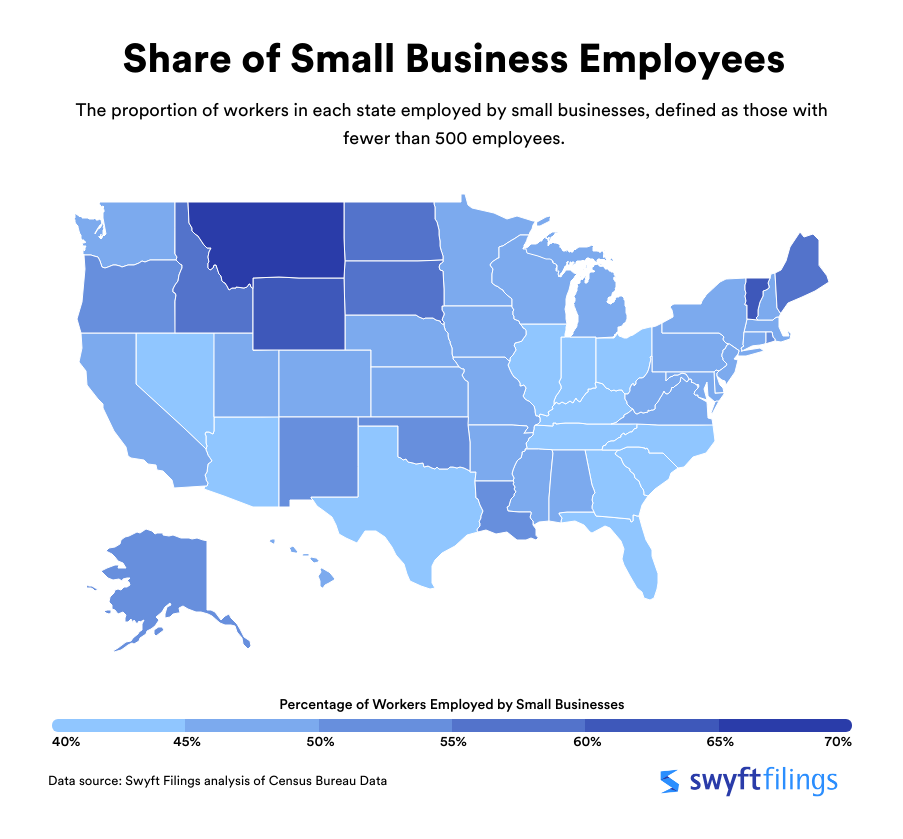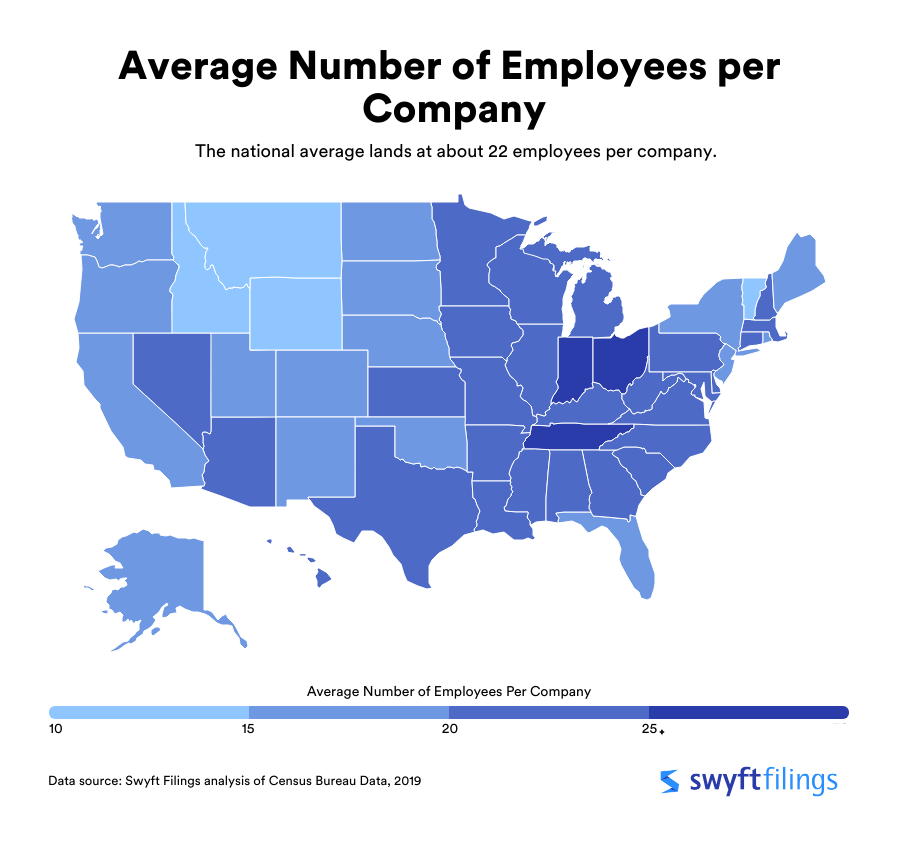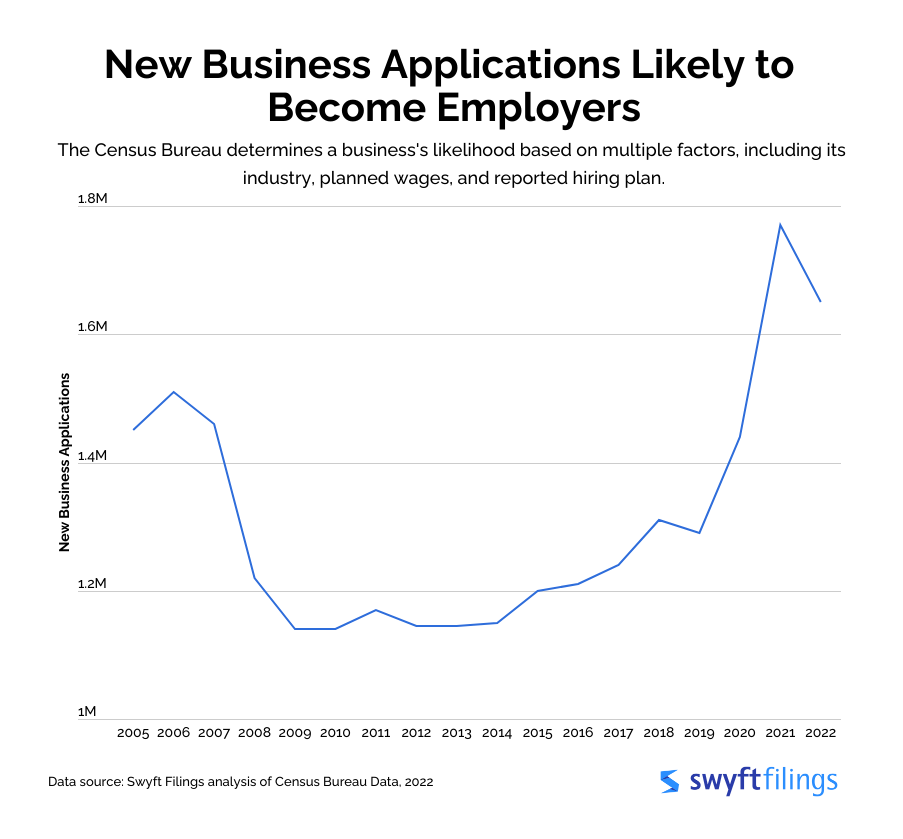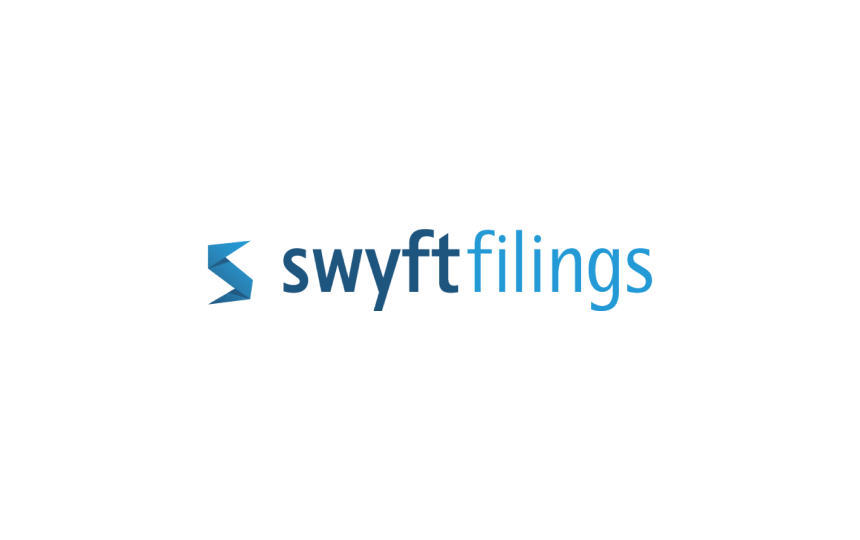States with the Highest Rates of Small Business Employment
Using Census Bureau data, Swyft Filings identified the states where small businesses, those with fewer than 500 workers, employ the largest share of people.
2021 was a record year for people deciding to work for themselves, with 5.4 million new business applications nationwide—and 2022 has followed close on its heels. Though not all companies will have employees, the surge could lead to a rise in small business jobs in years to come.
This analysis defines small businesses as having fewer than 500 employees, which comprise more than 99% of businesses nationwide. There were more than 6 million of them in the U.S. in 2019, the most recent year of the Census Bureau's Statistics of U.S. Businesses. These small businesses employed about 61.7 million people—a little less than half of all private workers—and paid nearly $3 trillion in wages.
Swyft Filings used Census Bureau data to identify which states have the highest rates of small businesses employment. States are ranked by the percentage of employees who worked at small businesses in 2019. The data excludes nonemployer businesses, private households, railroads, agricultural production, and most government entities.

It can take as little as 10 minutes to start an LLC online with Swyft Filings. Our experienced business specialists can help you save time and money while forming your LLC.
Small businesses employ less than half of the private workforce in most states
Nationally, 46% of employees worked for small businesses in 2019. Most states are close within that range, as well. But there are some notable exceptions.
In much of the northwest quadrant of the country, small companies held a larger share of total employees. Montana led the nation, with about 2 in 3 employees working for small businesses—surpassing the national average by 20 percentage points. Leading small business industries for Montana and neighboring states include construction, professional/scientific/technical services, and real estate/leasing, according to the Small Business Association (SBA).
The relatively low cost of living in the Midwest and Mountain regions means small businesses can afford to employ more people than in states with higher living expenses or where they have to compete with larger, high-paying corporations. Montana's companies benefit from its quality-of-life characteristics, such as work-life balance, outdoor activities, and the landscape's natural beauty, according to a Montana High Tech Business Alliance survey.
Vermont and Maine also stood out, particularly within the Northeast. Again, the largest industries for small businesses were construction and professional/scientific/technical services, according to the SBA. Most Vermont small businesses are sole proprietorships or unincorporated businesses with a single owner who may or may not have employees.

The US averages about 22 employees per business
Small businesses have 500 employees or less, but most are considerably smaller. Nearly 9 in 10 of all U.S. companies have fewer than 20 employees. On average, U.S. companies have about 22 employees.
The highest statewide average employment per business is 28 in Washington D.C. Again, the northern Mountain region maintains the lowest averages, namely in Montana, Idaho, and Wyoming, with Vermont following closely behind.

Business applications, including probable employers, surged in 2021
Of the 5.4 million business applications in 2021, nearly 1.8 million were likely employers. That's more than any single year in the past 15 years. In 2022, nearly 1.7 million more applications were deemed likely to become employers.
The Census uses a variety of factors to determine likely employers (formally called high-propensity business applications). Considerations include whether an application comes from an existing corporate entity, whether it indicates a hiring plan or planned wages, and if it's within a handful of industries that typically go on to employ others, such as accommodation, food services, manufacturing, or retail.
Startups are critical to innovation, job creation, and productivity. Though applications—likely employers or not—won't all materialize into companies, historically, startup activity has followed business application trends fairly closely. There's a good chance more companies, and in turn, small business jobs, will continue to grow in the months and years to come.
States with the Highest Proportion of Small Business Employees
51. Florida
Share of workers employed by small businesses: 40.5% (3.6 million)
Share of small businesses: 98.9% (465,494)
Annual payroll of small businesses: $154.9B (36.3% of state's private payroll)
2022 small business applications: 611,628 (34.3% likely to become employers)
50. Tennessee
Share of workers employed by small businesses: 42.2% (1.2 million)
Share of small businesses: 96.5% (97,229)
Annual payroll of small businesses: $49.0B (37.7% of state's private payroll)
2022 small business applications: 91,618 (33.1% likely to become employers)
48. Arizona (tie)
Share of workers employed by small businesses: 42.5% (1.1 million)
Share of small businesses: 97.0% (110,403)
Annual payroll of small businesses: $48.2B (37.2% of state's private payroll)
2022 small business applications: 115,700 (29.7% likely to become employers)
48. Georgia (tie)
Share of workers employed by small businesses: 42.5% (1.7 million)
Share of small businesses: 97.6% (181,536)
Annual payroll of small businesses: $76.3B (35.9% of state's private payroll)
2022 small business applications: 274,553 (27.7% likely to become employers)
47. Nevada
Share of workers employed by small businesses: 42.8% (540,004)
Share of small businesses: 95.6% (52,368)
Annual payroll of small businesses: $23.5B (40.4% of state's private payroll)
2022 small business applications: 62,240 (28.5% likely to become employers)
46. South Carolina
Share of workers employed by small businesses: 43.0% (837,615)
Share of small businesses: 96.7% (82,820)
Annual payroll of small businesses: $32.2B (38.6% of state's private payroll)
2022 small business applications: 91,604 (26.6% likely to become employers)
45. Kentucky
Share of workers employed by small businesses: 43.3% (722,253)
Share of small businesses: 96.1% (64,723)
Annual payroll of small businesses: $27.9B (37.2% of state's private payroll)
2022 small business applications: 42,973 (29.7% likely to become employers)
44. Indiana
Share of workers employed by small businesses: 43.8% (1.2 million)
Share of small businesses: 96.9% (106,588)
Annual payroll of small businesses: $50.6B (38.2% of state's private payroll)
2022 small business applications: 83,575 (30.5% likely to become employers)
43. North Carolina
Share of workers employed by small businesses: 44.4% (1.7 million)
Share of small businesses: 97.8% (178,487)
Annual payroll of small businesses: $71.7B (36.8% of state's private payroll)
2022 small business applications: 150,702 (30.4% likely to become employers)
42. Texas
Share of workers employed by small businesses: 44.5% (4.9 million)
Share of small businesses: 98.6% (452,239)
Annual payroll of small businesses: $233.3B (38.2% of state's private payroll)
2022 small business applications: 467,999 (30.7% likely to become employers)
40. Ohio (tie)
Share of workers employed by small businesses: 44.7% (2.2 million)
Share of small businesses: 97.7% (179,051)
Annual payroll of small businesses: $93.7B (38.4% of state's private payroll)
2022 small business applications: 140,751 (27.6% likely to become employers)
40. Illinois (tie)
Share of workers employed by small businesses: 44.7% (2.5 million)
Share of small businesses: 98.1% (251,107)
Annual payroll of small businesses: $126.9B (39.0% of state's private payroll)
2022 small business applications: 170,133 (36.8% likely to become employers)
39. Missouri
Share of workers employed by small businesses: 45.3% (1.2 million)
Share of small businesses: 97.3% (113,475)
Annual payroll of small businesses: $47.4B (37.8% of state's private payroll)
2022 small business applications: 81,264 (29.3% likely to become employers)
38. Massachusetts
Share of workers employed by small businesses: 45.4% (1.5 million)
Share of small businesses: 97.7% (141,939)
Annual payroll of small businesses: $90.9B (38.0% of state's private payroll)
2022 small business applications: 71,509 (39.5% likely to become employers)
37. Utah
Share of workers employed by small businesses: 45.5% (625,571)
Share of small businesses: 96.9% (68,371)
Annual payroll of small businesses: $27.1B (40.1% of state's private payroll)
2022 small business applications: 65,270 (28.5% likely to become employers)
34. Minnesota (tie)
Share of workers employed by small businesses: 46.0% (1.3 million)
Share of small businesses: 97.5% (116,317)
Annual payroll of small businesses: $57.8B (37.6% of state's private payroll)
2022 small business applications: 611,128 (32.8% likely to become employers)
34. Virginia (tie)
Share of workers employed by small businesses: 46.0% (1.6 million)
Share of small businesses: 97.6% (151,283)
Annual payroll of small businesses: $79.1B (40.1% of state's private payroll)
2022 small business applications: 123,783 (28.7% likely to become employers)
34. Mississippi (tie)
Share of workers employed by small businesses: 46.0% (441,099)
Share of small businesses: 95.8% (42,411)
Annual payroll of small businesses: $15.7B (41.5% of state's private payroll)
2022 small business applications: 55,303 (30.3% likely to become employers)
33. Pennsylvania
Share of workers employed by small businesses: 46.2% (2.6 million)
Share of small businesses: 98.1% (226,511)
Annual payroll of small businesses: $115.8B (39.3% of state's private payroll)
2022 small business applications: 139,033 (30.4% likely to become employers)
32. Iowa
Share of workers employed by small businesses: 46.6% (644,100)
Share of small businesses: 96.8% (61,192)
Annual payroll of small businesses: $26.4B (41.4% of state's private payroll)
2022 small business applications: 29,880 (30.3% likely to become employers)
31. Alabama
Share of workers employed by small businesses: 46.8% (822,668)
Share of small businesses: 96.4% (71,997)
Annual payroll of small businesses: $33.7B (42.4% of state's private payroll)
2022 small business applications: 71,247 (27.5% likely to become employers)
30. Arkansas
Share of workers employed by small businesses: 47.2% (497,605)
Share of small businesses: 96.3% (49,321)
Annual payroll of small businesses: $18.5B (39.9% of state's private payroll)
2022 small business applications: 37,756 (31.1% likely to become employers)
29. Delaware
Share of workers employed by small businesses: 47.4% (195,792)
Share of small businesses: 93.4% (19,768)
Annual payroll of small businesses: $9.7B (40.5% of state's private payroll)
2022 small business applications: 45,781 (31.8% likely to become employers)
28. Colorado
Share of workers employed by small businesses: 47.6% (1.2 million)
Share of small businesses: 97.6% (140,662)
Annual payroll of small businesses: $58.3B (41.0% of state's private payroll)
2022 small business applications: 116,563 (32.8% likely to become employers)
26. California (tie)
Share of workers employed by small businesses: 47.9% (7.4 million)
Share of small businesses: 99.2% (783,945)
Annual payroll of small businesses: $415.0B (38.5% of state's private payroll)
2022 small business applications: 490,306 (42.3% likely to become employers)
Start your business the right way by obtaining your federal tax ID EIN so you can open bank accounts, collect revenue, and hire new employees.
26. Michigan (tie)
Share of workers employed by small businesses: 47.9% (1.9 million)
Share of small businesses: 98.0% (170,405)
Annual payroll of small businesses: $85.4B (42.0% of state's private payroll)
2022 small business applications: 137,314 (28.0% likely to become employers)
25. New York
Share of workers employed by small businesses: 48.1% (4.1 million)
Share of small businesses: 98.9% (461,206)
Annual payroll of small businesses: $230.1B (38.2% of state's private payroll)
2022 small business applications: 299,049 (41.3% likely to become employers)
24. Connecticut
Share of workers employed by small businesses: 48.2% (741,920)
Share of small businesses: 96.7% (68,118)
Annual payroll of small businesses: $39.5B (39.4% of state's private payroll)
2022 small business applications: 44,683 (29.2% likely to become employers)
23. Nebraska
Share of workers employed by small businesses: 48.3% (413,735)
Share of small businesses: 96.3% (42,117)
Annual payroll of small businesses: $17.0B (43.1% of state's private payroll)
2022 small business applications: 20,592 (31.1% likely to become employers)
21. West Virginia (tie)
Share of workers employed by small businesses: 48.6% (269,473)
Share of small businesses: 94.9% (24,717)
Annual payroll of small businesses: $9.9B (41.6% of state's private payroll)
2022 small business applications: 13,813 (31.4% likely to become employers)
21. Washington DC (tie)
Share of workers employed by small businesses: 48.6% (257,236)
Share of small businesses: 92.3% (17,326)
Annual payroll of small businesses: $19.4B (43.3% of state's private payroll)
2022 small business applications: 14,328 (26.8% likely to become employers)
20. Wisconsin
Share of workers employed by small businesses: 48.8% (1.3 million)
Share of small businesses: 97.3% (105,731)
Annual payroll of small businesses: $53.3B (40.7% of state's private payroll)
2022 small business applications: 64,585 (29.8% likely to become employers)
19. New Jersey
Share of workers employed by small businesses: 49.2% (1.9 million)
Share of small businesses: 98.2% (191,253)
Annual payroll of small businesses: $96.6B (40.3% of state's private payroll)
2022 small business applications: 154,388 (29.2% likely to become employers)
18. Hawaii
Share of workers employed by small businesses: 49.3% (272,459)
Share of small businesses: 96.0% (24,677)
Annual payroll of small businesses: $11.6B (44.9% of state's private payroll)
2022 small business applications: 18,604 (31.1% likely to become employers)
17. Maryland
Share of workers employed by small businesses: 49.4% (1.2 million)
Share of small businesses: 97.3% (107,212)
Annual payroll of small businesses: $61.2B (44.7% of state's private payroll)
2022 small business applications: 99,365 (29.0% likely to become employers)
15. New Hampshire (tie)
Share of workers employed by small businesses: 49.7% (308,296)
Share of small businesses: 95.4% (29,544)
Annual payroll of small businesses: $15.2B (45.9% of state's private payroll)
2022 small business applications: 13,951 (31.3% likely to become employers)
15. Kansas (tie)
Share of workers employed by small businesses: 49.7% (601,426)
Share of small businesses: 96.0% (55,101)
Annual payroll of small businesses: $24.9B (43.6% of state's private payroll)
2022 small business applications: 31,147 (34.2% likely to become employers)
14. Washington
Share of workers employed by small businesses: 49.8% (1.4 million)
Share of small businesses: 98.0% (156,575)
Annual payroll of small businesses: $74.4B (38.9% of state's private payroll)
2022 small business applications: 88,824 (33.1% likely to become employers)
13. Oklahoma
Share of workers employed by small businesses: 51.1% (718,033)
Share of small businesses: 96.8% (70,983)
Annual payroll of small businesses: $29.0B (44.5% of state's private payroll)
2022 small business applications: 55,169 (30.5% likely to become employers)
12. Rhode Island
Share of workers employed by small businesses: 51.2% (227,699)
Share of small businesses: 95.1% (23,244)
Annual payroll of small businesses: $10.5B (46.2% of state's private payroll)
2022 small business applications: 10,954 (33.0% likely to become employers)
11. Alaska
Share of workers employed by small businesses: 52.3% (138,517)
Share of small businesses: 96.1% (16,691)
Annual payroll of small businesses: $7.5B (45.5% of state's private payroll)
2022 small business applications: 8,515 (35.2% likely to become employers)
10. Louisiana
Share of workers employed by small businesses: 52.7% (905,726)
Share of small businesses: 97.1% (79,135)
Annual payroll of small businesses: $38.7B (47.0% of state's private payroll)
2022 small business applications: 80,620 (26.9% likely to become employers)
9. New Mexico
Share of workers employed by small businesses: 53.7% (346,374)
Share of small businesses: 95.1% (32,776)
Annual payroll of small businesses: $13.7B (48.7% of state's private payroll)
2022 small business applications: 27,135 (28.0% likely to become employers)
8. Oregon
Share of workers employed by small businesses: 54.4% (893,405)
Share of small businesses: 97.5% (94,568)
Annual payroll of small businesses: $39.3B (44.9% of state's private payroll)
2022 small business applications: 49,671 (33.5% likely to become employers)
7. North Dakota
Share of workers employed by small businesses: 55.7% (196,770)
Share of small businesses: 95.2% (18,867)
Annual payroll of small businesses: $9.1B (49.9% of state's private payroll)
2022 small business applications: 7,961 (31.5% likely to become employers)
5. Maine (tie)
Share of workers employed by small businesses: 56.3% (293,748)
Share of small businesses: 96.6% (33,300)
Annual payroll of small businesses: $12.0B (49.7% of state's private payroll)
2022 small business applications: 12,986 (37.0% likely to become employers)
5. Idaho (tie)
Share of workers employed by small businesses: 56.3% (347,193)
Share of small businesses: 96.6% (41,174)
Annual payroll of small businesses: $13.1B (48.4% of state's private payroll)
2022 small business applications: 29,814 (32.8% likely to become employers)
4. South Dakota
Share of workers employed by small businesses: 58.0% (208,353)
Share of small businesses: 95.8% (21,473)
Annual payroll of small businesses: $8.0B (51.0% of state's private payroll)
2022 small business applications: 10,453 (32.5% likely to become employers)
3. Vermont
Share of workers employed by small businesses: 60.2% (157,131)
Share of small businesses: 95.6% (16,962)
Annual payroll of small businesses: $6.7B (56.3% of state's private payroll)
2022 small business applications: 7,512 (33.6% likely to become employers)
2. Wyoming
Share of workers employed by small businesses: 64.1% (132,595)
Share of small businesses: 95.6% (17,777)
Annual payroll of small businesses: $5.9B (56.6% of state's private payroll)
2022 small business applications: 41,863 (21.9% likely to become employers)
Ensure you hit all of your filing deadlines, remain compliant, and maintain your privacy with the support of our registered agent services.
1. Montana
Share of workers employed by small businesses: 66.8% (250,680)
Share of small businesses: 97.2% (32,614)
Annual payroll of small businesses: $9.6B (60.1% of state's private payroll)
2022 small business applications: 20,683 (31.3% likely to become employers)
Swyft Blog
Everything you need to know about starting your business.
Each and every one of our customers is assigned a personal Business Specialist. You have their direct phone number and email. Have questions? Just call your personal Business Specialist. No need to wait in a pool of phone calls.










